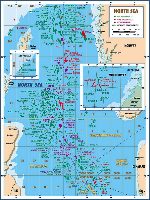Western Europe: Denmark
August 2000 Vol. 221 No. 8 International Outlook WESTERN EUROPE Robyn Fowler and Susannah James, Arthur Andersen-Petroleum Services Group, London Denm
WESTERN EUROPERobyn Fowler and Susannah James, Arthur Andersen-Petroleum Services Group, London DenmarkLicensing. The year started well with the Minister of Environment and Energy granting three new licenses under the Danish "Open Door" policy. Agip and DOPAS were awarded License 1/99 covering 13 blocks. The second license (2/99) was granted to Gustavson Associates, which is primarily a consultancy company. It covers 10 blocks in Quadrant 5707. Anschutz, a U.S. company, was awarded License 3/99, which covers 13 blocks. By the second quarter, an Amerada Hess-led group had also been awarded a license (4/99), which covers 11 blocks and 912 sq mi (2,372.1 sq km). The latter half of the year was somewhat quieter. DANOP was appointed co-operator of License 7/89, with Amerada Hess, and also assumed operatorship of License 11/98. In October, the Danish Energy Agency granted a two-year extension for the Third Round License 10/89 operated by Maersk Olie-og Gas AS. Two of the first licenses to be awarded under the Danish "Open Door" policy were relinquished by Amerada Hess (2/97 and 3/97). DONG (operator) partially relinquished 4/95, a Fourth Round license where 50% of the area has been surrendered, leaving an area of 418 sq mi (1,087.5 sq km).
In December, the Minister of Petroleum tabled a bill on the First Licensing Round. The bill included items on the general terms and conditions of the licenses, along with details of areas to be offered. The signing of the UK/Faroes Maritime Boundary agreement led to 162 new full and part blocks being formed in the Faroese sector. The First Round was opened in the middle of February 2000, with 56 whole blocks and 26 part-blocks offered. The government is aiming to make awards by August 2000. The government of Greenland and its Danish counterpart both authorized a new licensing policy for Greenland. Details were announced in April 1999, along with plans for a Second Licensing Round. These measures have been taken to bolster activity in the area. It was decided to resume the "Open Door" policy for areas offshore West Greenland between 60°N and 63°N, and between 68°N and 71°N. The policy is effective from October 1, 1999, and extends into the onshore sector on Nuussuaq-Disko and Jameson Land. Exploration and drilling. Drilling activity rose 200% between 1998 and 1999, when a total of nine wells (six exploration and three appraisal) were spudded. All six exploration wells were completed during the year, two of which were classed as oil wells, giving an exploration success ratio of 33%. The remaining four wells were completed without comment. Maersk had a particularly active year, drilling two-thirds of the wells. Statoil drilled two of the remaining wells, with Amerada Hess operating the final well. During 1999, Maersk revealed that exploration Well Nana-1X, on Block 5505/13, had successfully investigated the Halfdan structure. During the summer, Statoil drilled horizontal Well Sca-4 from a surface location in Block 5604/20 and found oil in the Siri North structure within Block 5604/14. Development and production. Two Danish fields came on stream during 1999. In May, production started from the Statoil-operated Siri field. The 60-million-bbl field is the first Danish development located outside of the Central Graben within a Paleocene play. The development consists of a jackup drilling rig bridge-linked to a jackup processing platform with six horizontal production and three water injection wells. In July, South Arne field came on stream bringing 150 million bbl of oil and 188 Bcf of gas into production. The field was developed using an integrated, concrete, gravity-based oil production and storage structure. Gas is exported to shore via a new pipeline, connecting the field to existing offshore infrastructure. Test production from the Halfdan structure also began in July, via two wells drilled from Skjold field. A plan to develop the field with a minimum facilities platform was approved in February 2000. It is planned to utilize nine producer / injector wells in the development of the field. Full production is expected to commence in mid-2001. Danish oil production rose by 26% in 1999 to a total of 110 million bbl
(301,000 bopd), largely due to the start-up of South Arne and Siri fields. Danish gas production also
increased, but by only 3.5% to 630 MMcfd or 231 Bcf for the year.
|



